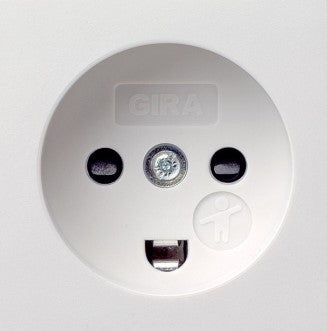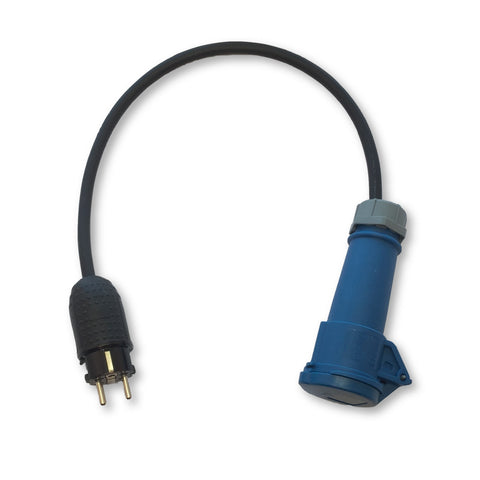For EV charging, please see the EV leads section.
Our wide range of heavy duty adaptors are designed to enable standard UK caravan hook-up leads to be used across Europe and Scandinavia from domestic and commercial sockets, where the standard 230v 16A CEE socket found on campsites is not available.
Using a camping hook up in the UK is relatively simple, as all sites have a correctly wired 230v 16A socket, commonly known as a CEE or commando. In contrast, connecting to sockets abroad can be a confusing minefield! Firstly you need to navigate a range of different sockets which look deceptively similar, yet may be in incompatible with some plugs, even when they physically fit together.
Secondly you need to overcome the frequent issue of reverse polarity. In simple terms, in the UK a 16A plug can only be inserted one way. If you face a socket, the live is always wired to the right receptacle (hole), with the neutral to the left.
UK campers and caravans expect the power to be configured in that way. If the polarity is reversed and a fault occur, the single pole circuit breaker MCB (if it still works in this reverse configuration) will trip, but disconnect the neutral connection. Whilst the equipment in your caravan will appear to be off, the live connection will still very much be live! Further guidance on reverse polarity can be found here. Use a polarity reversal adaptor in conjunction with any of the camping adaptors, where required.
Please see our guide for the definitive source of information on connecting caravans and motorhomes to campsites, domestic sockets, generators and EV charging points across the UK, Europe and Scandinavia.
Typical Application
The picture below illustrates a typical application, with a UK caravan hook up connected to a Schuko socket using the universal Schuko/French adaptor.

|
Schuko
French
|
Universal Schuko/French Adaptor The universal CEE 7/7 adaptor fits both Schuko and French types sockets and is the main adaptor required for the majority of Europe and Scandinavia. Schuko Sockets Unlike UK plugs and sockets, they can be connected either way around, and there is no convention as to whether sockets have the live wired to the left or right receptacle. A socket tester must be used to show which way the socket is wired (polarity). If it is correct, happy days - if not, simply pull out the plug and turn it 180 degrees. French Sockets The protruding earth pin means that the plug can only be inserted one way around, just like UK plugs. The major issue is that until 2002, there was no convention as to whether sockets had the live wired to the left or right receptacle. However, it is now more likely that the live will be wired to the right (as you face the socket). This cannot however be relied upon, as many sockets are still wired the other way, and to further confuse matters, the Czech standard still recommends wiring the live to the left! You therefore have a 50:50 chance of it being wired the correct way for your EV charger, and unlike with the Schuko socket, you cannot rotate the plug 180 degrees to solve the issue. Use a socket tester to show which way the socket is wired (polarity). If the polarity is incorrect, use a polarity reversal adaptor. |
|
Traditional Italian Socket New Bipasso Socket
|
Italian Adaptors 10A and 16A Historically Italy has had its own specific socket, available in 10A and 16A versions. However, many buildings now have the Bipasso/Schuko socket, which can be used with both Italian and Schuko plugs. The universal Schuko/French adaptor will therefore work anywhere in Italy where the Bipasso/Schuko socket is available. However the challenge may be in older buildings, where only traditional Italian sockets are provided. Whilst many sockets in Italy will accept both 10A and 16A plugs, some will only accept one type, so for complete peace of mind both adaptors would be required. Both Italian and Schuko plugs can be inserted either way around in the Bipasso/Schuko socket, so reverse polarity can be corrected by turning the plug 180 degrees. |
 |
Swiss Adaptor Switzerland and Liechtenstein use their own specific socket, available in 10A and 16A versions. 10A plugs can be inserted into 16A sockets, but the reverse is not possible. For complete peace of mind both adaptors would be required. Alternatively just the 10A version could be used as it will fit both sockets, although please note that with the 10A adaptor charging, the supply is limited to 10A. There is a convention to wiring the live, so reverse polarity should not be an issue. |
 |
Danish Adaptor Denmark and Greenland use their own 16A socket. Whilst the socket looks similar to a Schuko/French socket, they must not be used together. Although they will fit, the earth will not be connected, which is extremely hazardous. The Danish adaptor must be used for these sockets. From 2008 French sockets were allowed to be fitted in Denmark, with Schuko sockets supported from 2011. The universal Schuko/French adaptor will therefore work in Denmark where either of these sockets are fitted. Data on their prevalence is not available, and so it is likely that in many places a Danish adaptor will still be required. There is a convention to wiring the live, so reverse polarity should not be an issue. |
|
43mm diameter |
CEE 230v 16A Sockets Found at campsites and marinas across the UK and Europe. In the UK sockets are always wired with the correct polarity. Within Europe, reverse polarity is common. Always use a socket tester to check the supply and use a polarity reversal adaptor if required. |
|
57mm diameter |
CEE 230v 32A Adaptor Commonly used in industrial locations and power installations at temporary sites. The adaptor has an MCB unit, which protects the output at 16A. Please be aware of cheaper adaptors available online which do not include an MCB. These are a serious hazard, as if a fault occurs the cable and camper would not be protected by a 16A breaker. Subjecting the 16A rated cable and installation to up to 32A before the 32A supply MCB tripped would result in it becoming dangerously hot, risking an electrical fire. |
|
56mm diameter |
CEE 415v 16A Adaptor Commonly used in industrial locations and power installations at temporary sites. |
|
63mm diameter |
CEE 415v 32A Adaptor Commonly used in industrial locations and power installations at temporary sites. The adaptor has an MCB unit, which protects the output at 16A. Please be aware of cheaper adaptors available online which do not include an MCB. These are a serious hazard, as if a fault occurs the cable and camper would not be protected by a 16A breaker. Subjecting the 16A rated cable and installation to up to 32A before the 32A supply MCB tripped would result in it becoming dangerously hot, risking an electrical fire. |
 |
UK 13A Sockets The camping hook up can be connected to a standard UK 13A socket using this adaptor.
|
The Electrical Safety First website provides a useful resource to check the type of sockets used in any county worldwide. For more technical information, the Digital Museum of Plugs and Sockets provides a fascinating resource.
If you require an adaptor which is not listed, please do get in touch, as we can make adaptors for almost any international socket, many from stock.
Specification:
- Splash proof IP44 rated high quality German manufactured Menneke 230v 16A socket, compatible with the Tesla gen 2 16A lead. 32A connectors will be Gewiss.
- 0.3m of the largest diameter H07RN-F rubber cable which will safely fit the specific plug:
- 2.5mmsq - IEC 230v (16A), IEC 415v (16A)
- 1.5mmsq - Universal Schuko/French adaptor (16A), Danish adaptor (16A), Italian adaptor (16A), Swiss adaptor (16A)
- 1mmsq - Italian adaptor (10A), Swiss adaptor (10A)
- MCB protected adaptor use a Gewiss robust IP55 weatherproof DIN enclosure (overall dimensions W105mm x H170mm x D98mm) with a 16A type B MCB.
- Industrial specification H07RN-F rubber cable, specifically manufactured for harsh environments with high mechanical, chemical, water and UV resistance. Flexibility and performance is retained over a wide temperature range (-25 to 55°C). Find out what’s so special about this cable.
- PAT tested.



















